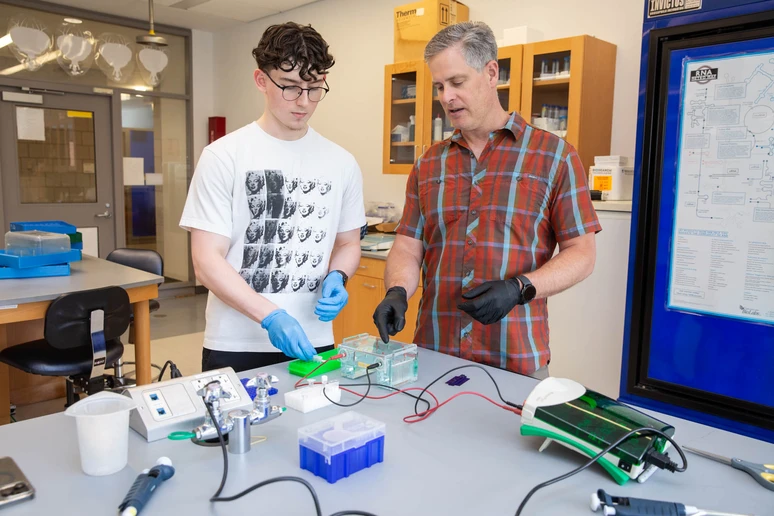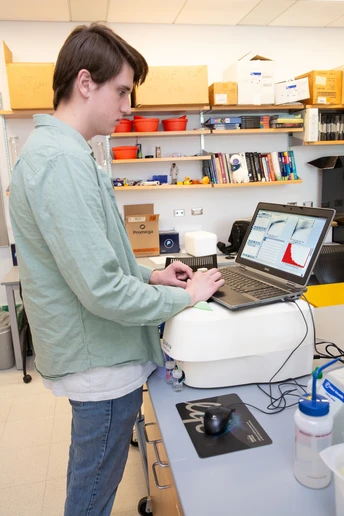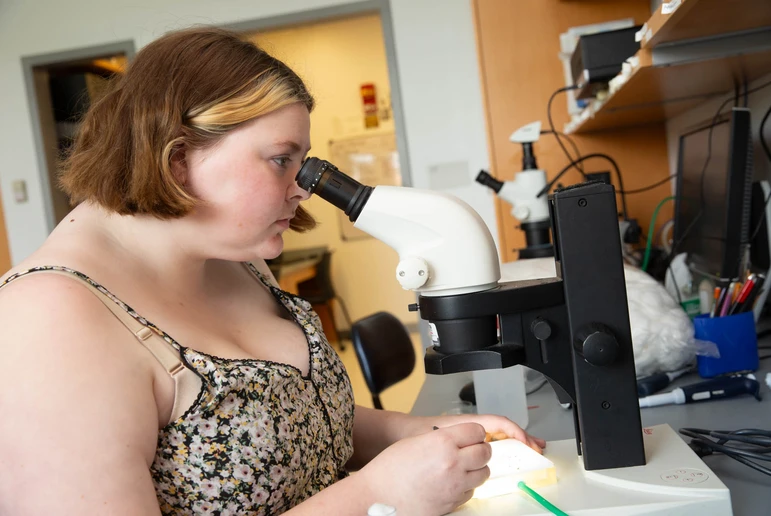

Gradimir Mesarich, a junior Molecular Genetics major, and Associate Professor Scott Ferguson discuss a procedure to determine if a segment of DNA is amplified.


Gradimir Mesarich, a junior Molecular Genetics major, and Associate Professor Scott Ferguson discuss a procedure to determine if a segment of DNA is amplified.
Summer research in biology is alive and well at SUNY Fredonia and includes eight undergraduate and graduate students.
Endowments through the Fredonia College Foundation are providing a total of $40,000 to fund a $5,000 stipend for each student to cover living expenses and research expenses. Student allocations were raised $500 this year.
The summer fellowship program provides opportunities for students to conduct research on campus or nearby sites to continue their education through experiential learning. Grants from the Holmberg Foundation and the Joseph and Jane (Schuster) Falcone Endowment for Scholarship and Research support the experiences.
Five students are pursuing M.S. degrees in Biology and three students will become juniors this fall. Many served in the research labs of their respective mentors for at least one semester or, in some cases, up to two years. Four of the five graduate students are SUNY Fredonia alumni.
Gavin Monaghan, of Rochester, NY, whose research, “The effect of CENP-O complex gene knockdown on the frequency of mitosis and mitotic defects in cancer cell lines,” is being mentored by Associate Professor Nicholas Quintyne.

In his research, Mr. Monaghan, a graduate student, is examining several proteins that make up a complex called CENP-O, and what happens when those proteins are experimentally knocked down or removed from the cell in terms of cell division.
The research is a good fit for Monaghan, who received a B.S. in Molecular Genetics in 2025 and already has considerable experience working on cancer cells and in cell biology, Dr. Quintyne explained. It gives him a new challenge of interest, focusing on a research question that’s important to better understanding kinetochore mechanics.
“It also sets him up to continue this work for his master’s thesis,” Quintyne added. Monaghan, who plans to enroll in a Ph.D. program, has conducted research in Quintyne’s lab for the last 2-1/2 years.
Two students – Max Higbee of Jamestown, NY, and Gradimir Mesarich of Woodside, NY – are working on projects that seek to understand how the development growth factor Gurken is regulated.
“This growth factor is analogous to the human Transforming Growth Factor alpha (TGF-a) that is found in humans and is an important driver of cancer progression,” explained Associate Professor Scott Ferguson, the mentor of both students.
Fruit flies are being used as a simple system to model control of the gene to better understand how it functions in humans.

Higbee, a graduate student whose research title is “Investigating the Role of Barentsz of grk in D. melanogaster,” is studying a protein called Barentsz, named after the Dutch Arctic explorer William Barentsz whose boat became trapped in the Arctic ice, that is necessary for RNA transport and translation control.
When the Barentsz protein is missing, RNA becomes trapped, like Barntsz’s boat in the ice, and is unable to reach its proper localization, Dr. Ferguson said. “Max is in the process of examining ovaries from flies that are normal and mutant for the btz gene to determine if and how this change impacts Gurken. This will be the foundation for their master’s thesis.” They graduated with a B.S. in Molecular Genetics in May 2025.
Mr. Mesarich, a junior majoring in Molecular Genetics, is studying a gene known by the serial number CG19822 that was assigned when the genome was sequenced because it has not been previously studied. The title of his research is "Evaluation of the Effects of CG18622 Mutations During Drosophila Oogenesis."
What he has discovered is that when CG18622 is mutated, Grk production increases. Mesarich is in the process of making new versions of this gene so he can track its movement during development to determine when, how and where it regulates grk translation.
“We are excited at the prospect of being the first to describe this gene and as a result will be able to name it,” Ferguson said.
“Both students will develop their molecular biology skills this summer by manipulating DNA in the lab, creating genetically engineered fly lines and studying them using our laser scanning confocal microscope,” Ferguson said.
Two students – Rachel Echevarria, of Fredonia, NY, and Natalie Evans, of Hamburg, NY – are conducting wildlife research with Associate Professor Karry Kazial that involves bats.
“Bat behavioral response to avian predators and expansion of acoustic surveying for bat activity and species richness in WNY” is the title of research by Ms. Echevarria, a graduate student.
“We are looking to establish whether a predator-prey relationship exists between nocturnal birds of prey and bats,” Dr. Kazial explained.
There are conflicting results regarding the impact of nocturnal birds of prey as well as a lack of data, so new data can help to guide conservation efforts.
Playbacks of owl species will be conducted in the field and lab to determine bat calling and other behavioral responses. Tifft Nature Preserve is a prospective research site.
The research is directly connected to Echevarria’s career goal to conduct research to promote wild animal conservation with the New York State Department of Environmental Conservation or National Park Service. It also continues research Echevarria did last summer, resulting in a larger data set to answer research questions.
Echevarria began working in Kazial’s lab as an undergraduate majoring in Environmental Science in the Fall 2023 semester, when she helped to set up the animal colony and began pilot research for her summer 2025 research.
“Monitoring bat species richness and activity in WNY through acoustic surveys” is the title of research by Ms. Evans, a junior Biology major. Its primary goal is to assess the species richness and diversity of bats in various Western New York locations.
Acoustic surveys will be compiled to gather information on bat species' presence and activity. The new data will contribute to a long-term understanding of population trends and bat ecology, thus supporting efforts to inform conservation strategies, Kazial explained.
Kazial’s lab has compiled multi-year surveys in past summers at Chautauqua Institution and at the College Lodge. Eighteen Mile Creek will be added as a study site this summer.
Evans has received vaccination and training to work hands-on with bats.
“Natalie is looking to gain experience in every aspect of scientific research, from proposal development to presentation of results,” Kazial said. This is her first research experience in Kazial’s lab.
Gaining experience in every aspect of scientific research, from proposal development to presentation of results, is an objective Evans has set to achieve from the experience. Her career goal is to go into medical practice and improve her ability to think critically, interpret data, understand complex biological systems and work collaboratively with others.
Two students – Alaina Hogue, of Venus, PA, and Hannah Reid, of Frankfort, NY – are conducting research with SUNY Distinguished Teaching Professor William Brown.
In “Genetics of wild populations of praying mantids,” Ms. Hogue, a junior, is estimating genetic diversity in wild populations of praying mantids. She is doing molecular genetic work that utilizes tools developed in collaboration with Ferguson’s lab, Dr. Brown explained. “Our eventual goal is to use this information to learn more about breeding biology, patterns of migration, and genetic differentiation of wild populations,” Brown said.
As a Molecular Genetics major with a special interest in entomology, the research dovetails perfectly with Hogue’s interests. It will also increase her skills in the lab and build her understanding of the scientific process, Brown noted.
While Hogue and Brown collaborate on multiple projects in his lab, this project is Hogue’s primary responsibility. She briefly worked on it last fall and will continue through the 2025 Fall semester.
In “Assessing insect personalities,” Ms. Reid is examining distinct personalities of insects and how the personalities relate to major developmental and ecological factors. Behavioral biologists define animal personality as consistent differences between individuals in behavior, including traits such as exploration and risk taking.
“Hannah is studying personality in two species, beetles and mantids, assessing food and host-plant preferences, sociality and general exploration. In the case of beetles, she is specifically looking to see whether personalities change with metamorphosis,” Brown explained.
With mantids, she is looking for variation in predatory behavior and risk taking in the context of sexual cannibalism.
The project continues research that Reid, a graduate student, began last year in Brown’s lab. She has a B.S. in Biology from another SUNY school.
Hector Lopez, graduate student, of Macedon, NY, is performing research with Associate Professor Todd Backes. He received a B.S. in Exercise Science this year.